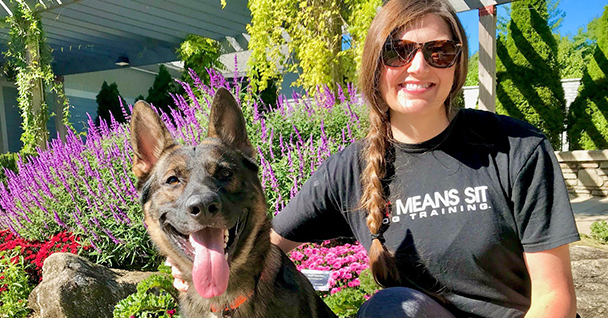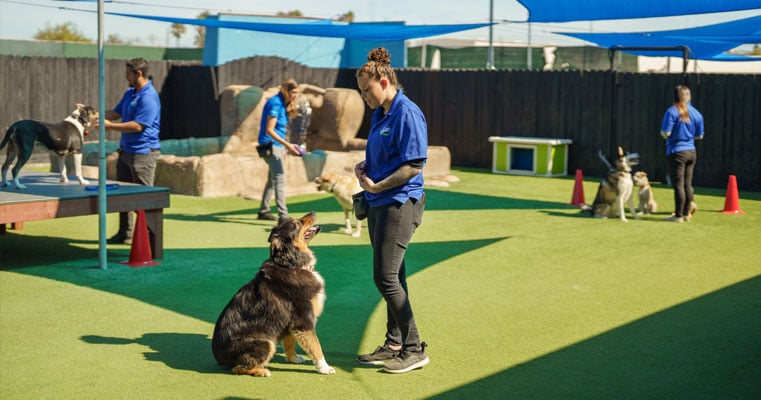Important Tips for Successful Dog Training: A Guide for Family Pet Owners
Efficient dog training is a diverse procedure that calls for a tactical strategy tailored to both the pet dog's personality and the owner's objectives. Trick parts such as developing consistent commands, employing positive reinforcement, and assisting in early socialization play important roles in cultivating a well-adjusted canine friend. Nonetheless, lots of pet proprietors experience challenges that can impede progress, causing disappointment and uncertainty. Recognizing exactly how to navigate these obstacles can dramatically enhance the training experience, ultimately changing the relationship in between proprietor and pet dog. What are the necessary methods that can be utilized to ensure success in this undertaking?
Comprehending Dog Behavior
Understanding pet behavior is crucial for efficient training and cultivating a harmonious connection in between dogs and their proprietors. dog training. Canines interact largely through body language, vocalizations, and activities, making it essential for proprietors to interpret these signals properly.

Socializing plays a significant role in canine actions; direct exposure to numerous atmospheres, people, and various other animals can considerably impact a pet dog's temperament. Furthermore, factors such as breed characteristics and specific personality must assist training techniques, as some types may have particular behavioral attributes that demand tailored methods. By understanding these components, proprietors can produce a supportive atmosphere that motivates positive behavior, bring about effective training end results and a much deeper bond with their pet dogs.
Developing Constant Commands
Efficient interaction with your pet dog starts with developing constant commands. This fundamental component of training is crucial for fostering understanding between you and your pet dog. Uniformity in the commands you utilize guarantees that your canine can reliably associate details words or expressions with the preferred behaviors.
When picking commands, select clear, distinctive words that are simple to claim and differentiate from one an additional. Avoid utilizing similar-sounding commands that might confuse your dog. Using "rest" and "remain" is proper, however "rest" and "struck" could lead to misconceptions.
Additionally, preserve the exact same tone and quantity for each and every command. Canines are delicate to singing signs, so varying your tone can create confusion.
It is just as vital to ensure that all relative get on the exact same page relating to the commands utilized. A united front in command usage will certainly protect against combined signals and enhance the learning process.
Positive Support Strategies
The power of favorable support in pet training depends on its capability to encourage wanted habits through incentives and appreciation. This method is based in the concept that habits followed by beneficial outcomes are most likely to be repeated. By incorporating positive support into your training regimen, you can effectively form your dog's behavior in a constructive manner.
To execute favorable reinforcement, it's important to determine what motivates your dog, whether it be deals with, toys, or verbal appreciation. When your pet carries out a wanted activity, such as sitting on command, immediately reward them with a reward or love. This organization in between the command and the positive outcome reinforces their understanding.
It's important to timing the benefits properly; providing the support within secs of the desired actions assists your dog make the connection (dog training). Furthermore, uniformity is vital-- ensure that all member of the family make use of the exact same commands and reward systems to avoid confusion
:max_bytes(150000):strip_icc()/a-dog-trainer-giving-a-hand-command-to-black-labrador-dog--1153579373-cb14c8fb30724468a702c972910c6f2a.jpg)
Progressively, you can minimize the regularity of deals with as your pet discovers the actions, transitioning to applaud or intermittent rewards. This approach not only cultivates a solid bond between you and your pet dog however also advertises a favorable discovering setting, making educating a delightful experience for both.
Socialization and Interaction
Consistently exposing your canine to a range of settings, individuals, and other animals is important here for their social advancement. Socialization ought to start early, ideally throughout the critical home window of 3 to 14 weeks, when young puppies are most receptive to new experiences. Older pets can likewise profit from ongoing socializing initiatives.
Introduce your dog to different setups, such as parks, pet-friendly shops, and city locations. This exposure assists them adapt to different stimuli, reducing anxiousness and fear actions. Motivate favorable interactions with other dogs and individuals, ensuring that these encounters are secure and controlled to promote self-confidence.
Utilize structured playdates with genteel canines, as this can improve your canine's social abilities and teach them proper habits. Obedience courses and training sessions likewise offer excellent possibilities for socialization, enabling your pet dog to communicate with others in a supervised atmosphere.
Monitor your pet dog's body movement throughout communications, as this will her response help you assess their comfort degree. Gradually increase exposure to even more tough situations while making sure that each experience declares. A well-socialized canine is more probable to display balanced habits, making them a happiness to have in any type of setup.
Resolving Common Training Obstacles
Every dog owner will experience training challenges at some time, no matter of their pet dog's age or socialization level. Determining typical problems such as stubbornness, diversions, and fearfulness can assist in establishing effective approaches for improvement.

Progressively introduce interruptions as the canine ends up being a lot more skillful in commands. Short, constant training sessions are additionally reliable in maintaining focus.
Terror can hinder a pet's learning process. Progressive desensitization to the resource of fear, coupled with positive support, can help relieve anxiousness. Patience is crucial; never ever force a dog right into a situation that triggers distress, as this may intensify the problem.
Ultimately, understanding and resolving these typical obstacles with a structured approach will cultivate an extra productive training experience, strengthening the bond between pet dog and owner while promoting efficient knowing.
Final Thought
In recap, effective pet training counts on a detailed understanding of canine behavior, the facility of consistent commands, and the application of favorable reinforcement methods. Socializing plays a crucial function in developing well-adjusted family pets, while dealing with usual training difficulties calls for persistence and flexibility. By executing these essential methods, pet proprietors can foster a solid bond with their dogs and promote preferable behaviors, eventually leading to a harmonious partnership between people and their canine friends.
Comprehending pet behavior is necessary for effective training and promoting an unified relationship in between pooches and their owners.Socializing plays a considerable role in canine habits; exposure to various environments, individuals, and other animals can significantly impact a pet dog's character.The power of positive reinforcement in pet dog training exists in its ability to urge wanted behaviors with benefits and praise. weblink By integrating positive reinforcement right into your training routine, you can successfully form your canine's habits in a useful fashion.
In summary, successful canine training relies on a detailed understanding of canine actions, the establishment of regular commands, and the application of positive reinforcement methods.